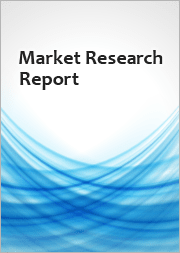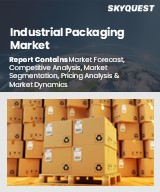
|
시장보고서
상품코드
1532329
세계의 경질 포장용 플라스틱 시장(2024-2030년)Plastics in Rigid Packaging Market, Global, 2024-2030 |
||||||
혁신적인 비지니스 모델과 지속가능성 중시의 증가에 의해 경질 포장용 플라스틱은 변혁적인 성장을 달성하고 있다.
경질 포장이란 형태를 유지하고, 탄성 변형이 없거나 제한적이며, 일반적으로 독립적인 포장을 말합니다. 플라스틱이 선택되는 이유는 더 가볍고, 다용도하고, 화학적으로 불활성이며, 내구성이 뛰어나고, 저렴하기 때문입니다.
포장 또한 마케팅에서 중요한 역할을 하고 있습니다. 눈길을 끄는 포장과 최적의 라벨링은 구매 결정에 영향을 미칠 수 있습니다. 경질 포장은 원료 공급업체, 컨버터/포장업체, 재활용 업체, 다운스트림 브랜드 소유주에게 성장 기회를 제공합니다. 인구 통계의 변화와 소득 수준 증가는 소비자 제품, 나아가 경질 포장에 대한 수요에 영향을 미칩니다. 소비자의 라이프스타일이 변화함에 따라 즉시 사용 가능한 제품에 대한 수요도 증가하고 있습니다. 이에 따라 편리함과 휴대성을 제공하는 소형 팩으로의 전환이 수년째 인기를 끌고 있으며, 브랜드 소유주들이 경질 플라스틱으로 전환하고 있습니다. 또한 경질 포장용 플라스틱의 사용은 해당 다운스트림 산업의 성장과 함께 성장할 것으로 예상됩니다. 식품 및 음료, 화장품, 의약품, 퍼스널케어 제품, 홈케어 제품 등 수요가 경질 포장용 플라스틱에 대한 큰 수요를 창출하고 있습니다.
폴리에틸렌 테레프탈레이트(PET)는 경질 포장에 가장 널리 사용되는 폴리머로, PET에 대한 수요의 대부분은 음료 산업에서 발생합니다. 생수, 탄산음료, 영양음료의 소비 증가가 PET 병에 대한 수요를 주도하고 있습니다. 또한 알코올 음료 포장이 유리에서 PET 병으로 전환되고 있으며, PET 병은 유리를 대체할 수 있는 잠재적인 재료로 자리매김하고 있습니다. 소형 1회용 병에 대한 선호도 또한 PET 병에 대한 수요를 증가시키고 있습니다. 또한 F&B 용도의 rPET에 대한 높은 수요도 이 부문의 성장을 가속하고 있습니다.
용도 측면에서 경질 플라스틱은 식품 및 음료 포장 용도로 가장 널리 사용되고 있습니다. 이러한 수요 증가는 인구 증가와 인구 통계학적 변화로 인한 소비 증가에 크게 의존하고 있습니다. 도시화, 1인 가구 증가, 앉아서 생활하는 생활방식의 채택과 같은 인구 통계학적 변화는 소용량 포장의 편리한 포장 사용을 촉진합니다. 음료 산업은 경량화 추세로 인해 큰 혜택을 누리고 있습니다. 브랜드 소유주들은 유리나 금속과 같은 무거운 소재보다 가벼운 경질 플라스틱을 선호하기 때문입니다. 그 결과, 식품 및 음료 산업의 성장과 함께 경질 포장의 사용도 확대될 것으로 예상됩니다.
경질 포장용 플라스틱 시장은 세계 기업과 특정 지역에서 특정 플라스틱 유형에 특화된 여러 지역 및 지역 제조업체가 존재하므로 매우 세분화되어 있습니다. 생산자들은 기본적으로 가격과 재료의 품질로 경쟁하고 있습니다. 아시아태평양 국가들은 인구가 매우 많아 경질 포장용 플라스틱에 대한 지역적 수요가 증가하고 있습니다. 또한 유럽과 북미와 같은 선진 지역에서는 지속가능성에 대한 관심이 높아지면서 기존 플라스틱을 재활용/재생한 플라스틱으로 대체하므로 물량이 꾸준히 증가하고 매출도 크게 성장할 것입니다. 또한 바이오플라스틱이 경질 플라스틱 생태계에 침투함에 따라 평균 가격은 시간이 지남에 따라 상승하여 예측 기간 중 매출 성장을 가속할 것으로 예상됩니다.
목차
전략적 필수 요건
- 왜 성장이 어려워지고 있는가?
- The Strategic Imperative 8(TM)
- 경질 포장용 플라스틱 업계에 대한 주요 전략적 필수 요건의 영향
- Growth Pipeline Engine(TM)을 촉진하는 성장 기회
성장 기회 분석
- 개요
- 분석 범위
- 세분화 : 경질 포장용 플라스틱
- 지역적 범위
- 주요 경쟁사
- 성장 지표
- 소비자·소매업 포장재료에 대한 인식
- 플라스틱 유형, 특성, 용도
- 폴리머, 플라스틱 유형과 생물 분해성
- 변환 프로세스와 용도
- 밸류체인
- 밸류체인 분석
- 성장 촉진요인
- 성장 촉진요인 분석
- 성장 억제요인
- 성장 억제요인 분석
- 예측의 전제조건
- 촉진요인·억제요인 그래픽 요약
- 매출·수량 예측
- 매출·수량 예측 분석
- 폴리머 유형별, 매출 예측
- 폴리머 유형별, 수량 예측
- 폴리머 유형별, 매출·수량 예측 분석
- 가격 동향과 예측
- 폴리머·유형별 가격 동향과 예측
- 가격 동향과 예측
- 최종 산업별, 매출 예측
- 최종 산업별, 수량 예측
- 최종 산업별, 매출·수량 예측 분석
- 지역별, 매출 예측
- 지역별, 수량 예측
- 지역별, 매출·수량 예측 분석
- 경쟁 환경
- 경쟁 Tier 분석
- 플라스틱 포장의 주요 사용자
- 플라스틱 소비량 : 무알코올 음료 상위 기업별
- 플라스틱 소비량 : 식품 상위 기업별
- 플라스틱 소비량 : 홈·퍼스널케어 상위 기업별
- 플라스틱 소비량 : 주류 상위 기업별
- 플라스틱 소비량 : 홈케어 상위 기업별
- 플라스틱 소비량 : 퍼스널케어 상위 기업별
경질 플라스틱 포장의 순환 경제
- 순환 경제
- 순환 경제 분석
성장 기회 분석 : 폴리에틸렌
- 부문 특징과 개요
- 성장 지표
- 매출과 수량 예측
- 최종 산업별, 매출 예측
- 최종 산업별, 수량 예측
- 예측 분석
- 지역별, 매출 예측
- 지역별, 수량 예측
- 지역별, 예측 분석
성장 기회 분석 : 폴리프로필렌
성장 기회 분석 : 폴리에틸렌 테레프탈레이트(PET)
성장 기회 분석 : 기타
성장 기회 유니버스
- 성장 기회 1 : 폴리스티렌 대체품
- 성장 기회 2 : 바이오플라스틱 생산 인프라
- 성장 기회 3 : 플라스틱 재활용 에코시스템
다음 스텝
KSA 24.08.26Plastics in Rigid Packaging are Experiencing Transformational Growth due to Innovative Business Models and the Rising Emphasis on Sustainability
Rigid packaging is packaging that maintains its shape and form, exhibiting no or limited elastic deformation, and is generally self-supporting and free-standing. Plastic is the material of choice because it is lighter, versatile, chemically inert, durable, and inexpensive.
Packaging also plays a critical role in marketing. Eye-catching packaging with optimum labeling can influence purchase decisions. Rigid packaging creates growth opportunities for raw material suppliers, converters/packaging manufacturers, recycling companies, and downstream brand owners. Changing demographics and rising income levels affect the demand for consumer products and, subsequently, rigid packaging. With changing consumer lifestyles, the demand for ready-to-use products is also increasing. Hence, the shift to smaller pack sizes that offer convenience and portability has been gaining traction over the years, compelling brand owners to switch to rigid plastics. Further, the use of plastics in rigid packaging is anticipated to grow in tandem with the growth of the downstream industries it caters to. The demand for foods and beverages, cosmetics, pharmaceuticals, and personal and home care products creates a significant demand for plastics in rigid packaging.
Polyethylene terephthalate (PET) is the most widely used polymer in rigid packaging applications. Most of the demand for PET comes from the beverage industry. Rising consumption of bottled water, carbonated drinks, and nutritional drinks will drive the demand for PET bottles. Further, the rising shift of alcoholic beverage packaging from glass to PET bottles positions the material as a potential replacement for glass. The preference for smaller, single-serve bottles also increases the demand for PET. In addition, the considerable demand for rPET in F&B applications will boost segmental growth.
From an applications standpoint, rigid plastics are most widely used in food and beverage packaging applications. This increasing demand strongly relies on rising consumption owing to increasing population and demographic shifts. Changing demographics such as urbanization, rising single-income households, and the adoption of a sedentary lifestyle promote the use of convenient packaging in small-serve packages. The beverages industry is another driving factor; it largely benefits from the lightweighting trend because brand owners prefer lightweight rigid plastics rather than heavier substrates such as glass and metals. As a result, the use of rigid packaging is expected to expand in tandem with the growth witnessed by the food and beverage industry.
The market for plastics in rigid packaging is highly fragmented with the presence of global players and several regional and local producers that focus on specific plastic types in particular regions. Producers fundamentally compete based on price and material quality. The significantly high population in APAC countries augments the regional demand for plastics in rigid packaging. Further, the strong focus on sustainability in developed regions such as Europe and North America will ensure a steady growth in volume and strong revenue growth as they substitute conventional plastics with recycled/recyclable ones. As bioplastics also penetrate the rigid plastic ecosystem, average prices are anticipated to increase over time, fueling revenue growth over the forecast period.
Table of Contents
Strategic Imperatives
- Why Is It Increasingly Difficult to Grow?
- The Strategic Imperative 8™
- The Impact of the Top 3 Strategic Imperatives on the Plastics in Rigid Packaging Industry
- Growth Opportunities Fuel the Growth Pipeline Engine™
Growth Opportunity Analysis
- Overview
- Scope of Analysis
- Segmentation: Plastics in Rigid Packaging
- Geographic Scope
- Key Competitors
- Growth Metrics
- Consumer & Retail Perception of Packaging Materials
- Plastic Types, Properties and Applications
- Polymers, Plastic Types and Bio-degradability
- Conversion Processes and Applications
- Value Chain
- Value Chain Analysis
- Growth Drivers
- Growth Driver Analysis
- Growth Restraints
- Growth Restraint Analysis
- Forecast Assumptions
- Graphic Summary of Drivers and Restraints
- Revenue and Volume Forecast
- Revenue and Volume Forecast Analysis
- Revenue Forecast by Polymer Type
- Volume Forecast by Polymer Type
- Revenue and Volume Forecast Analysis by Polymer Type
- Pricing Trends and Forecast
- Pricing Trends and Forecast by Polymer Type
- Pricing Trends and Forecast Analysis
- Revenue Forecast by End Industry
- Volume Forecast by End Industry
- Revenue and Volume Forecast Analysis by End Industry
- Revenue Forecast by Region
- Volume Forecast by Region
- Revenue and Volume Forecast Analysis by Region
- Competitive Environment
- Competitive Tier Analysis
- Major Users of Plastic Packaging
- Plastic Consumption by Top Nonalcoholic Beverage Company
- Plastic Consumption by Food Top Company
- Plastic Consumption by Top Home and Personal Care Company
- Plastic Consumption by Top Alcoholic Beverage Company
- Plastic Consumption by Top Home Care Company
- Plastic Consumption by Top Personal Care Company
Circular Economy in Rigid Plastic Packaging
- Circular Economy
- Circular Economy Analysis
Growth Opportunity Analysis: Polyethylene
- Segment Characteristics and Overview
- Growth Metrics
- Revenue and Volume Forecast
- Revenue Forecast by End Industry
- Volume Forecast by End Industry
- Forecast Analysis
- Revenue Forecast by Region
- Volume Forecast by Region
- Forecast Analysis by Region
Growth Opportunity Analysis: Polypropylene
- Segment Characteristics and Overview
- Growth Metrics
- Revenue and Volume Forecast
- Revenue Forecast by End Industry
- Volume Forecast by End Industry
- Forecast Analysis
- Revenue Forecast by Region
- Volume Forecast by Region
- Forecast Analysis by Region
Growth Opportunity Analysis: Polyethylene Terephthalate
- Segment Characteristics and Overview
- Growth Metrics
- Revenue and Volume Forecast
- Revenue Forecast by End Industry
- Volume Forecast by End Industry
- Forecast Analysis
- Revenue Forecast by Region
- Volume Forecast by Region
- Forecast Analysis by Region
Growth Opportunity Analysis: Others
- Segment Characteristics and Overview
- Growth Metrics
- Revenue and Volume Forecast
- Revenue Forecast by End Industry
- Volume Forecast by End Industry
- Forecast Analysis
- Forecast Analysis
- Revenue Forecast by Region
- Volume Forecast by Region
- Forecast Analysis by Region
Growth Opportunity Universe
- Growth Opportunity 1: Polystyrene Alternatives
- Growth Opportunity 2: Bioplastics Production Infrastructure
- Growth Opportunity 3: Plastics Recycling Ecosystem
Next Steps
- Your Next Steps
- Why Frost, Why Now?
- List of Exhibits
- Legal Disclaimer



















